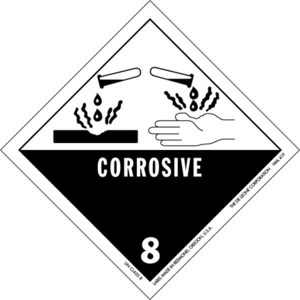Corrosive substance facts for kids
A corrosive substance is something that can seriously damage or destroy another material it touches. For people, the main dangers include harm to the eyes, skin, and the tissues under the skin. If you breathe in or swallow a corrosive substance, it can hurt your breathing tubes and stomach. When your body touches a corrosive substance, it can cause a chemical burn.
Contents
What Are Corrosive Substances?
The word 'corrosion' comes from a Latin word meaning 'to gnaw'. This helps us imagine how these substances seem to 'eat away' at things, like skin.
Sometimes, people use the word 'caustic' as a similar term. However, 'caustic' usually refers only to strong bases, especially alkalis. It doesn't typically describe acids, oxidizers, or other corrosive materials that are not alkaline. The word 'acid' is also often used to mean any corrosive substance, but this isn't always precise.
Corrosives vs. Irritants
A small amount of a corrosive substance, or a very weak one, is usually just an irritant. An irritant might cause redness or itching, but it won't destroy the tissue. A corrosive substance, however, causes much more serious damage.
Corrosives vs. Poisons
Corrosive substances are different from poisons. Corrosives cause immediate damage to the parts of the body they touch. Poisons, on the other hand, might affect your whole body internally, and their harmful effects might take some time to show up.
How Corrosives Affect Materials
Corrosion can also happen to non-living things, like metals. For example, when iron rusts, it's a type of corrosion. This happens when iron reacts with water and air. In a worldwide safety system called the Globally Harmonized System, the symbol for "corrosive" is used for substances that quickly corrode metals and also for those that cause chemical burns to skin.
See also
 In Spanish: Corrosión para niños
In Spanish: Corrosión para niños



